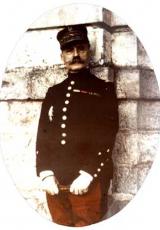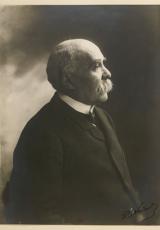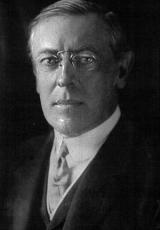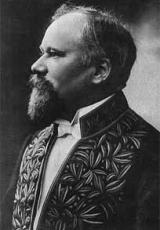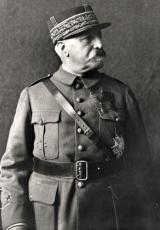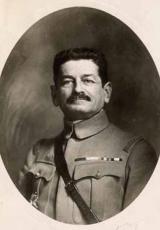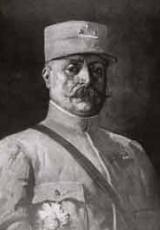La Paix
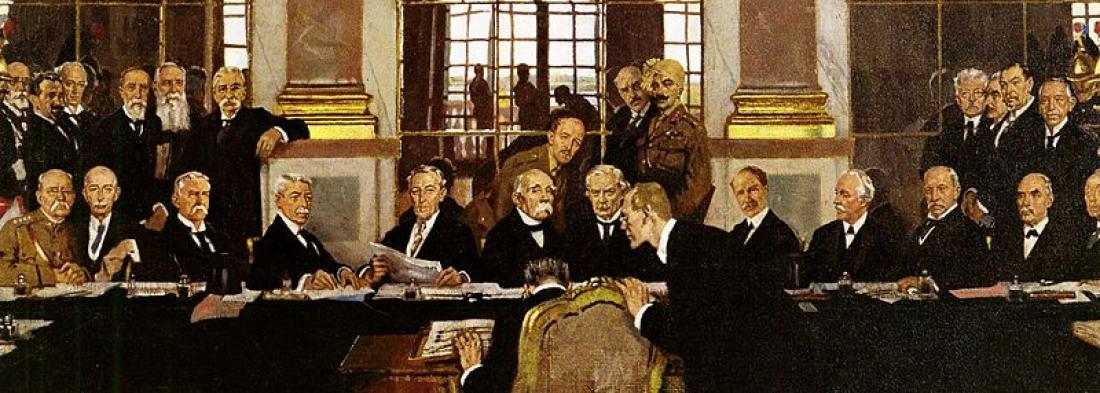
Corps 1
1919 The first armistice of 11 November 1918, lasting 36 days, was extended by the Allies on 13 December 1918, and on 16 January and 16 February 1919. Thus, on 16 January in the station at Trier (in the Rhineland), Marshall Foch renewed the armistice agreement with the German delegates, whilst in Paris preparations were being made for the signing of a peace treaty.
Corps 2
It was decided that the peace talks would be held in France, as this country had suffered most from the war. Although emerging victorious from the conflict, France had in effect been bled dry: 1.4 million dead, 6.5 million hectares of land affected, 750,000 houses destroyed and more than 6,000 bridges damaged. Moreover, she had lost 87% of the capital she had held in 1913 and the Franc had been devalued by 75% compared to the dollar. The victory had made the government popular, but the social climate was soon to become strained: strikes and rebellions broke out, encouraged by the inflation in prices and the freezing of salaries. On 19 January, an anarchist injured Clemenceau. The creation of the new "Third International" on the 2 March in Moscow had an impact on the workers' movement: on 1 May, violent demonstrations in Paris left more than 500 of the forces of law and order injured. This climate was reflected in the attitude of French MPs towards the content of the future treaty: the treaty for "revenge" or "peace between nations". On the Quai d'Orsay on 18 January 1919 the conference opened, bringing together representatives from 27 allied nations. The French delegation was led by Clemenceau, the British by Prime Minister Lloyd George, the United States' by President Wilson and the Italian by Prime Minister Orlando. Bolshevik Russia and the defeated countries were not invited. On the suggestion of the heads of state of the major countries, Clemenceau was designated president.
A council of the Ten was formed, with each country represented by its head of Government and Minister for Foreign Affairs, supported by 52 specialised committees. Its major function was the creation of a council of four, which was to become three when the Italian, Orlando, left the conference for a week in protest against Wilson's opposition to the annexation of Fiume by Italy. Various strategies were to conflict with each other. Clemenceau had two priorities: to seek reparations from Germany in proportion to the losses suffered by France, and to make sure that this country could not start another war. For Wilson, the most important thing was to uphold respect for the right of nations to make their own decisions. For his part, Lloyd George gave priority to creating a balanced Europe, dealing carefully with Germany so as to avoid French domination and to fight against Bolshevism.
Italy was mostly preoccupied with the Adriatic and Japan with German territories in the Pacific. Four problems arose: - The Rhine: The French wanted a fixed military border in the Rhineland and the autonomy of the German states to the west of the Rhine, or at least an international presence in the Rhineland. But they only achieved the demilitarisation of the left bank of the Rhine and the guarantee of Anglo-American intervention in the event of a Franco-German conflict - The Saar river: The French called for its annexation. They only received the rights to its collieries for 15 years. - The Adriatic: Italy wanted to acquire the Adriatic islands. Wilson opposed it. - Financial problems: the establishment of a commission with a view to setting German debts was decided for 1921. On 7 May the treaty was considered to be sufficiently well developed as to be presented to the German Minister for Foreign Affairs, von Brockdorff-Rantzau, who immediately questioned the terms. Fearing a refusal to sign, Lloyd George had some of the text edited for 16 June to include some concessions. This impression of a climb-down provoked anti-German demonstrations in Versailles. Von Brockdorff-Rantzau returned to Germany with five days in which to ratify the proposal.
In Germany at this time the political situation was barely stable: the uprisings by the extreme left had been suppressed, but the unrest continued. Elections led to a new assembly in Weimar, which, on 11 February, appointed Ebert president of the Republic. Once it was made public, the document resulting from the conference led to a governmental storm: since Ebert would not oppose it, Chancellor Scheidemann protested and resigned on 20 June, to be replaced immediately by Bauer. On 22 June, the Weimar government gave its agreement and the next day German members of parliament approved the text by 237 votes to 138. As Germany had been excluded from the conference, the text was considered to be a "Diktat". In Berlin, French flags seized during the 1870-1871 war were burned; at the Scottish Scapa Flow base, Admiral von Reuter scuttled the German fleet which was waiting to be handed over to the British navy: 5 battle cruisers, 11 battle ships and 50 destroyers were sunk. The 435 articles of the treaty included territorial, economic, military and financial clauses. Germany was thus to lose 70,000 km² in Europe (The Alsace-Lorraine region was handed back to France, Schleswig to Denmark and the Polish state was created etc.) and her colonies were to be shared between the victorious nations.
28 JUNE 1919 Germany, held responsible for all the damage of the war, had to pay 269 billion Goldmarks (400 billion gold francs), including 52% to France, and hand over her commercial fleet, railway stock, coal etc. Oversees possessions were sequestrated. Her army, whose high-command had been disbanded, was not allowed to own any tanks, aircraft or submarines and could not comprise of more than 100,000 enlisted men. War criminals, where identified, were to be prosecuted. In the château at Versailles, the Hall of Mirrors was fitted out for the ceremony for the signing of the treaty. All the delegations of the allied and enemy countries were present, with the exception of China, who refused one of the clauses in the treaty allowing Japan control of German territories in China. In the waiting rooms, courtyards and gardens, there gathered a crowd of journalists from around the world and spectators wanting to witness this unique event that was to conclude the world war.
Clemenceau opened the session. At 3 pm the five German delegates were brought into the hall. The head of protocol, Becq de Fouquières, brought in the red leather-bound treaty. A short address by Clemenceau preceded the signing, which began at 3.12 pm. In complete silence, Müller, the Minister for Foreign Affairs and Bell, Minister for the Colonies both signed, followed by Wilson, Lloyd George and Clemenceau and then the other delegates. At 3.50 pm it was all over. The treaty was to come into force on 11 January 1920. Clemenceau, who had invited five seriously disfigured veterans to the ceremony, made a point of saluting them. Outside, the crowd showed its delight. The 40 strong German delegation re-boarded its special train at Noisy-le-Roi.
1919-1922 On 20 October 1920, French MPs approved the text by 372 votes in favour, 53 against and 74 abstentions.
Other treaties were signed later; with Austria at the château of Saint-Germain-en-Laye on 10 September 1919; with Bulgaria at Neuilly on 27 September; with Hungary at the château du Grand Trianon at Versailles on 4 June 1920; with Turkey at Sèvres, on 10 August 1920. At the end of the Greco-Turkish war (1921-1922), this last treaty would be replaced by the Treaty of Lausanne (1923), which was more favourable towards the Turks. These treaties altered territorial maps. The empires (Austro-Hungary, Russia, Turkey) were dismembered, some new countries were created (Czechoslovakia, the Kingdom of the Serbs, the Croats and the Slovenians, Poland etc.) and others became larger (France, Romania, Denmark, Belgium etc.). To avoid the horrors of a new war, on the suggestion of the Americans an organisation was created, before whom all international disputes could be brought: the League of Nations (L.O.N.).
In reality, the situation was only superficially favourable to peace. In the new countries, numerous national minorities remained, each proclaiming allegiance to its own homeland, the ruined German economy was unable to repay debts at the set amount and the American Senate refused to ratify the treaty on 20 November 1919 and would not join the L.O.N. The decision by the U.S.A. rendered obsolete the military guarantee given to France in the event of a German attack. In addition to all of this, fighting on European soil did not completely cease. And so in 1920, Poland, fearing a communist advance, sent troops to Russia, who successfully counter-attacked. With the aid of officers commanded by General Weygand, the Poles succeeded in repelling the Russians. Between 1920 and 1922, war raged between Greece and Turkey. On 16 November 1919, French elections led to a coalition, with the right holding the majority. On 17 January 1920, Deschanel was elected President of the Republic with 734 votes. Clemenceau, the "Father of Victory", attacked by the left, who considered the treaty of Versailles too harsh and by the right, who criticised him for having weakened in the face of British demands, only received 53 votes.
VICTORY On the morning of 13 July 1919 the President of the Republic, Poincaré, was in Amiens. With the Minister for Finance, Klotz, and the Minister for the Liberated Regions, Lebrun, he met mayors from the Somme, before being received by the Bishop, Monsignor de Villerabel.
In the afternoon at the town hall in Paris, he awarded Marshals' honours to Foch, Joffre and Pétain and decorated the flags of the units. In the capital, where artists such as André Mare, Louis Süe and Gustave Jaulmes rallied round to decorate the place de l'Etoile and some nearby intersections, there was great excitement. A work by André Mare, a 17m high cenotaph dedicated to those who had died in the war, was given pride of place near the Arc-de-Triomphe. Clemenceau held private prayers there in the evening. At the roundabout on the Champs-Elysées, four alters were built, dedicated to the Martyred cities of Arras, Reims, Soissons and Verdun next to two pyramids constructed from piled up German canons. On 14 July from 6 am onwards, an enormous crowd gathered to line the length of the route the cortège would take from the Etoile to the Place de la République. At 8 am, President Poincaré, accompanied by the President of the Chamber, Deschanel, and Clemenceau, placed a wreath of orchids in front of the cenotaph before taking to the stage. At 8.35 am the procession began. Heralded by drums and trumpets, 1,000 disabled war veterans led the way, followed by Marshals Foch and Joffre, mounted on horseback and holding their decorated batons, and then by Generals from the Inter-Allied High Command. There then followed in alphabetical order (Americans first and Czechoslovakians last) all the Allied contingents with their leaders and their flags.
Behind Marshal Pétain and General de Castelnau, the French army marched to the sound of the Madelon, the military march of the Lorraine region, played by the Sambre-et-Meus regiment. Enthusiastic spectators applauded the representatives of twenty army corps, the Eastern army, the Army of Africa, and the colonial army etc. led by their commanders, including Generals Fayolle, Gouraud, Mangin, Guillaumat and Admiral Ronarc'h. On arriving in the Place de la République, Foch, commander of the allied armies in 1918, took his place next to the statue of Marianne to salute all these soldiers, the symbolic representatives of all those who had held out throughout the four years of the war. The ceremony ended at 12.15, but celebrations lasted late into the night, when fireworks lit up the enormous jubilant crowds. Victory was celebrated in all of the allied capitals, as well as in Madrid, Geneva and Luxembourg, the only country without an army occupied by the Germans since 2 August 1914. In the minds of all these people, it really was the "war to end all wars", the last ever war.
Personalities
Related articles
- 14th of July (Bastille Day)
- 1919, le logement des sinistrés à leur retour sur les zones du front en Picardie
- War Memorials
- Les marraines de guerre
- L'émancipation des femmes dans la Grande Guerre
- The Eastern Front: 1915 - 1919
- L'assaut final
- 11 November: a day of remembrance
- La Victoire... et ensuite ?
- L'année 1918 : la rupture de l'équilibre


